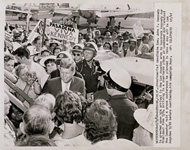• Image of John F. Kennedy, Burbank, California by Robert Flora
• Disposable cameras
• Cropping markers, such as L-shaped pieces of cardboard
• Poster board or mat board
• Paper and pens
|
 |
 |
 |
1. Examine the image of John F. Kennedy, Burbank, California, using the following
questions:
• Where are these people?
• Look carefully from the foreground to the background. What are some of the people holding in their hands?
• Look closely at the people that make up the crowd. What are the people reacting to? How are they reacting?
• What can we tell about the central figure?
What do you see that supports your conclusions? (He is popular, and is greeted with support from the crowd. The man in the image is then-presidential candidate Senator John F. Kennedy.)
• How has the photographer emphasized the central figure?
Use the elements of art to discuss how Flora uses line, repetition, and contrast in this photograph. (Flora has framed the shot with his camera, creating a cross pattern of repeating heads that terminate in the center and focus our attention on Senator Kennedy. Implied lines direct our attention to the senator. He also uses contrasts of light and dark to make the senator stand out from the crowd, for example, by placing him in front of the dark uniform of the police officer.)
2. Ask students what they think a photographer must be aware of and think about when trying to capture an image quickly. (They should keep in mind the framing of the image, the interaction of key figures in the viewfinder. A photographer must also be aware of the contrasts of lights and darks in the scene.)
3. Have students use a camera to capture images around their school that tell a story. Disposable cameras work well for this project since they simulate the way that photographers made images prior to the 1990s. Polaroid or digital cameras would also work. Students can also use their own cameras to search in their neighborhoods for images.
4. After film is developed and printed, have students bring their images back to class and choose one that they think is most successful at vividly telling a story. (Discuss how photographers in the past used contact sheets to see all of the images they had taken. A photographer would use a loupe, or magnifying glass, to examine the small images on the sheet and decide which one was most successful. Explain that a contact sheet is very much like the sheets of small thumbnails you sometimes get when you order photographic prints today.)
5. Next, have students use the elements of art to analyze their own image just as they did when they analyzed Robert Flora's photo. Once they have analyzed their photo, have students use cropping Ls or a frame to isolate areas of their photo and change the composition. Cropping the image can help focus attention on an area of the image. Often, press images are cropped or changed before they are printed. To see an example of crop marks on a photograph, examine the photograph Nagasaki Mushroom Cloud.
Ask students to consider whether cropping the image and taking unnecessary details or dead space out would make their image more visually interesting. What information would cropping leave out of the image? How would it change the story the image tells? Have students use poster board or mat board to create a frame to crop their image.
6. Have students write an evaluation of their process, including how they took the image, information about what interested them in the image, and the story the image tells. Their evaluation should include the reasons why they selected that image and what they thought was successful and unsuccessful, both from the perspective of design and of storytelling. If they made dramatic changes from their original photo in the process of cropping the image, this should also be discussed.
7. Discuss students' images in a class critique.
|
 |
 |
 |
| John F. Kennedy, Burbank, California, Robert Flora, September 9, 1960. Copyright permission courtesy of Corbis-Bettmann |
 |
|
 |
The use of photographs as visual documents has been valued from its beginnings, and most people think of a photograph as an objective record of a moment of reality. However, photographs are not entirely objective. Photographers make choices each time they take an image, and photographs can also be physically manipulated. This is especially pertinent in today's age of digital images, which are so easily manipulated.
• What are some issues with photo manipulation that occur today with digital photography?
• Should photos made for newspapers or magazines be altered in any way? Why or why not?
• How does the possibility of alteration affect the credibility of modern press photography?
|
 |
 |
 |
Common Core Standards for English Language Arts
Grades 6–12
SPEAKING AND LISTENING
Comprehension and Collaboration
1. Prepare for and participate effectively in a range of conversations and collaborations with diverse partners, building on others' ideas and expressing their own clearly and persuasively.
2. Integrate and evaluate information presented in diverse media and formats, including visually, quantitatively, and orally.
Visual Arts Content Standards for California Public Schools
Grades 9–10
1.0 Artistic Perception
Develop Perceptual Skills and Visual Arts Vocabulary
1.1 Identify and use the principles of design to discuss, analyze, and write about visual aspects in the environment and in works of art, including their own.
Analyze Art Elements and Principles of Design
1.4 Analyze and describe how the composition of a work of art is affected by the use of a particular principle of design.
3.0 Historical and Cultural Context
Diversity of the Visual Arts
3.3 Identify and describe trends in the visual arts and discuss how the issues of time, place, and cultural influence are reflected in selected works of art.
|
 |

|
 |


